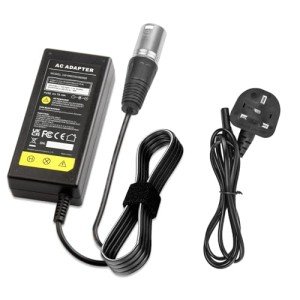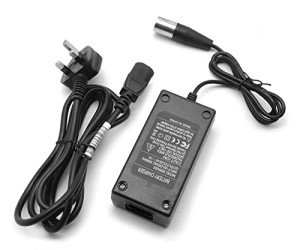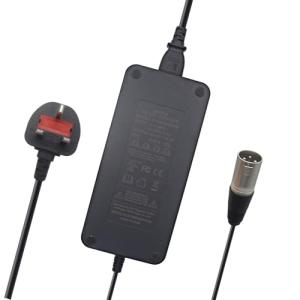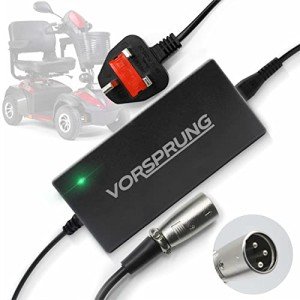Mobility scooters have become essential tools for many individuals, enhancing their independence and improving their quality of life. These vehicles are particularly helpful for those who face mobility challenges due to age, disability, or injury. A key component in ensuring the optimal performance of a mobility scooter is its battery system. For those operating scooters powered by 60-volt batteries, understanding the 60V battery charger is crucial. This guide provides valuable insights into what a 60V battery charger is, how it works, and the best practices for maintaining the longevity of your mobility scooter’s battery system.
What is a 60V Battery Charger?
A 60V battery charger is specifically designed to charge 60-volt batteries, which are commonly used in high-performance mobility scooters. These chargers convert alternating current (AC) from a wall outlet into the direct current (DC) needed to recharge the battery. The charger ensures that the battery receives the appropriate voltage and current levels required for a safe and efficient charging process.
Key Features of 60V Battery Chargers
- Voltage Regulation: A quality charger ensures that the voltage remains stable, preventing overcharging and potential damage to the battery.
- Current Limitations: Chargers typically have a maximum current output to ensure that the charging process remains safe and efficient.
- Smart Charging Technology: Many modern chargers feature advanced technology that can adjust the charging rate based on battery levels, preventing overheating and battery life reduction.
- LED Indicators: Most 60V chargers include LED lights to show the charging status—indicating whether the battery is charging, fully charged, or if there is an error.
The Importance of Using a Dedicated 60V Charger
Using a charger specifically designed for 60-volt batteries is crucial for various reasons:
- Safety: A charger that is not rated for 60V can lead to overcharging, which can damage the battery or pose a fire risk.
- Efficiency: A dedicated charger enables faster and more efficient charging, leading to reduced downtime for the scooter.
- Battery Longevity: Using the correct charger helps maintain the battery’s health, extending its lifespan and reducing the frequency of replacements.
How to Choose the Right 60V Battery Charger
When selecting a 60V battery charger for a mobility scooter, there are several factors to consider:
- Compatibility: Ensure that the charger is compatible with the specific battery model used in your mobility scooter.
- Charging Speed: Evaluate the charger’s amperage output. Higher amperage can charge the battery faster.
- Build Quality: Look for chargers with robust construction and safety features, such as over-voltage protection and overheating safeguards.
- Warranty and Support: Choose a charger with a warranty and access to customer support in case of issues.
Best Practices for Maintaining Your Mobility Scooter Battery
Maintaining the battery of a mobility scooter is essential to ensure reliable performance. Here are several practices that can help maximize battery life and efficiency:
- Regular Charging: It is best to charge the scooter’s battery after each use, even if it hasn’t been entirely depleted.
- Avoid Deep Discharge: Frequently allowing the battery to discharge to very low levels can harm its overall lifespan.
- Temperature Considerations: Store and charge the battery in a controlled environment, avoiding extreme temperatures. Heat is particularly detrimental to battery health.
- Routine Inspections: Regularly inspect the battery terminals for corrosion and clean them properly to maintain a good electrical connection.
- Use Proper Charging Equipment: Always use the manufacturer-recommended 60V charger to avoid potential risks associated with mismatched voltage.
Frequently Asked Questions (FAQs)
1. Can I use a standard charger for a 60V battery?
No, using a charger not designed for 60V batteries can cause serious damage and pose safety risks. Always use a dedicated 60V battery charger.
2. How long does it take to charge a 60V battery fully?
Charging times can vary based on the charger specifications and the battery capacity. Generally, a 60V battery may take anywhere from 6 to 12 hours to charge fully.
3. What are the signs of a failing mobility scooter battery?
Signs include reduced range, a battery that does not hold a charge, physical swelling, or leakage. If any of these symptoms occur, consult with a technician.
4. How often should I replace my mobility scooter’s battery?
A typical lead-acid battery lasts around 1-2 years, while lithium batteries can last 3-5 years or more, depending on usage and maintenance.
5. Are there any specific maintenance tips for lithium batteries?
Yes, lithium batteries prefer partial discharging rather than deep discharges, and they do best when stored at around 50% charge if not in use for extended periods.
In summary, a 60V battery charger is an integral component for those using mobility scooters powered by 60-volt batteries. Understanding its features and benefits, selecting the right charger, and adhering to best practices for battery maintenance can significantly enhance the performance and longevity of a mobility scooter. This knowledge ensures users can continue enjoying their independence and mobility with utmost efficiency and safety.







